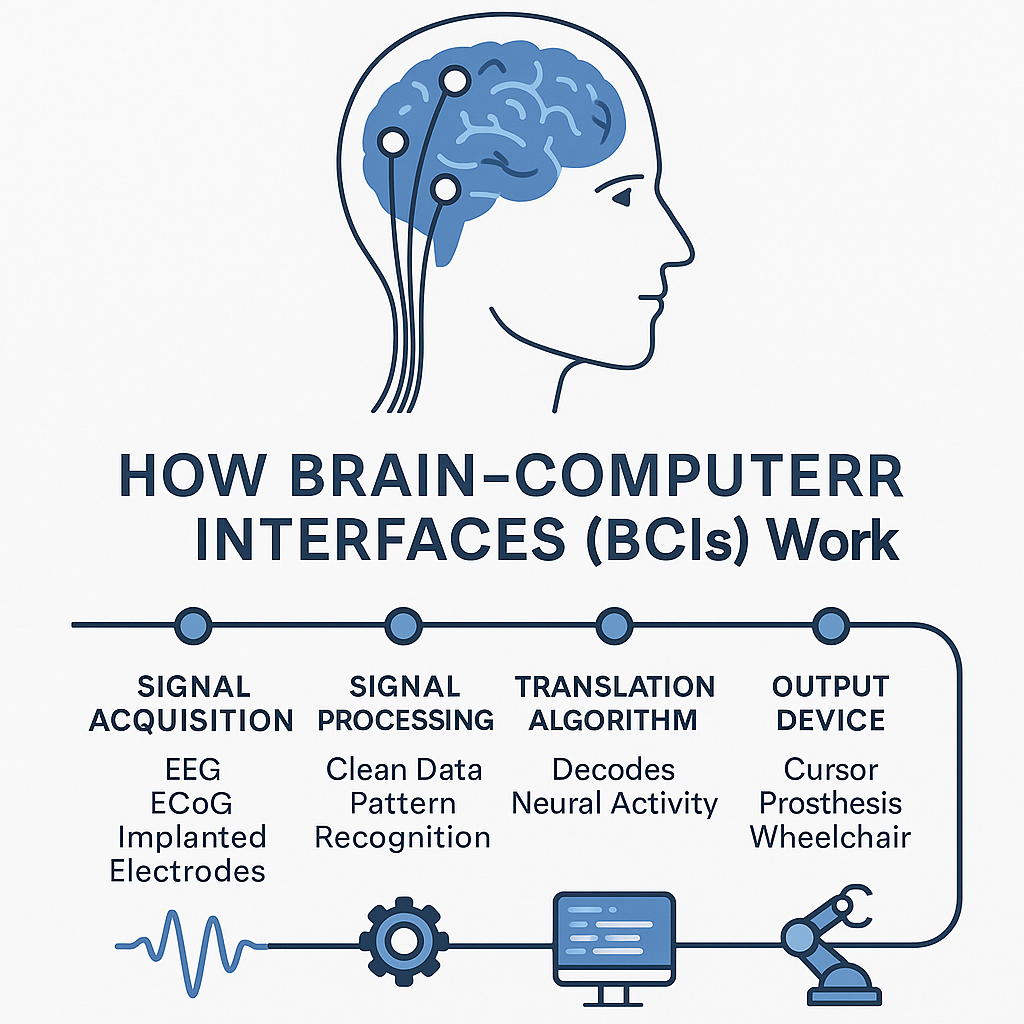Explore how brain-computer interfaces (BCIs) connect the human brain with machines, their core technologies, use cases in healthcare and beyond, and ethical implications.
🧠 What Are Brain-Computer Interfaces (BCIs)?
Imagine controlling a computer, a robotic arm, or even typing words — just by thinking. That’s the revolutionary promise of Brain-Computer Interfaces (BCIs).
Once a concept confined to science fiction, BCIs are now a growing area of research and innovation, with real-world applications in medicine, communication, and human augmentation.
In this post, we’ll explore:
- What BCIs are
- How they work
- Their current and future applications
- Ethical and technical challenges
🧬 Definition: What Is a BCI?
A Brain-Computer Interface (BCI) is a direct communication pathway between the brain’s neural signals and an external device — such as a computer, robotic limb, or software system.
The goal: Interpret brain activity and translate it into commands that machines can understand — without relying on physical movement or speech.

⚙️ How Does a BCI Work?
Most BCIs involve four key components:
1. Signal Acquisition
Electrodes or sensors detect brain activity, typically using:
- EEG (Electroencephalography) – non-invasive, measures electrical activity on the scalp
- ECoG (Electrocorticography) – semi-invasive, placed on the surface of the brain
- Implanted Microelectrodes – invasive, read signals directly from neurons
2. Signal Processing
Raw brain signals are noisy. The system uses filters and machine learning models to:
- Clean the data
- Identify patterns (e.g., motor intention or imagined speech)
3. Translation Algorithm
Algorithms decode brain patterns into specific outputs — like moving a cursor or selecting a letter.
4. Output Device
This could be:
- A robotic arm
- A screen for communication
- A game controller
- A wheelchair
🧠 Types of BCIs
| Type | Description | Invasiveness |
|---|---|---|
| Non-Invasive | Uses scalp electrodes (EEG) | Low |
| Semi-Invasive | Electrodes placed under the skull (ECoG) | Moderate |
| Invasive | Implanted directly into brain tissue | High |
🧪 Real-World Applications of BCIs
🧑⚕️ Medical Rehabilitation
- Helping paralyzed individuals control prosthetics or type
- Restoring movement via neural implants (e.g., spinal cord injury recovery)
- Treating epilepsy or Parkinson’s disease with responsive brain stimulation
🗣️ Communication Aids
- Letting locked-in patients (e.g., with ALS) spell words using only brain signals
- Imagined speech BCIs for “mind typing”
🧠 Cognitive Enhancement
- Potential future use in memory augmentation
- Improving focus or treating ADHD with neurofeedback
🕹️ Gaming and Control
- Controlling avatars, drones, or smart home devices by thought
- Companies like Neurable and NextMind developing VR headsets with neural input
🧪 Research and Monitoring
- Understanding neuroplasticity
- Studying brain disorders in real time
🚀 Companies and Projects Pushing BCI Forward
| Company | Focus Area |
|---|---|
| Neuralink (Elon Musk) | Implantable BCIs for motor control and communication |
| Blackrock Neurotech | Clinical-grade implantable BCIs |
| Synchron | Minimally invasive BCIs via blood vessels |
| OpenBCI | Open-source EEG devices for developers and researchers |
| CTRL-Labs (acquired by Meta) | Neural wristbands for AR/VR interaction |
⚖️ Ethical and Technical Challenges
❗ Privacy & Security
- Brain data is deeply personal — how do we protect it?
❗ Consent & Autonomy
- Who controls the device? Who owns the decoded thoughts?
❗ Invasiveness
- Implantable BCIs carry surgical risks and ethical dilemmas
❗ Bias & Accessibility
- BCIs must work across different brain types, conditions, and cultures
🔮 The Future of BCIs
While today’s BCIs are mostly used in research and medical contexts, future breakthroughs could enable:
- Thought-based user interfaces
- Merged AI-human cognition (brain-to-cloud systems)
- Fully immersive neural VR
- Mind-controlled vehicles or environments
Still, it will take years — or decades — for mainstream adoption. Key hurdles include precision, affordability, and public trust.
🧩 Key Takeaways
- BCIs create a direct communication link between the brain and computers
- They hold massive potential in healthcare, communication, and control
- The technology ranges from wearable EEG devices to surgically implanted chips
- Ethical concerns around privacy, consent, and neurological safety must be addressed